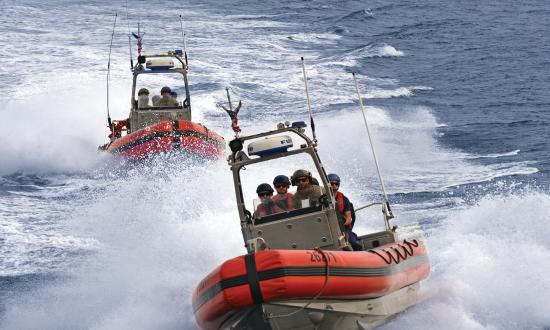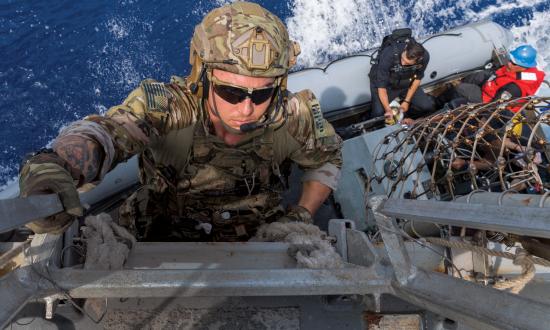It would be an understatement to say the Coast Guard plays a critical role in the new era of great power competition. The service has several important missions to execute supporting a strong national posture and assisting allies in this changing landscape. The so-called Pax Americana, which endured beyond the end of the Cold War, is giving way to a new model, and the Coast Guard will be important in developing a new era of global peace and prosperity.
A 1992 paper from the U.S. Naval War College, “Toward a Pax Universalis,” outlined several possible ways forward in maintaining global security following the dissolution of the Soviet Union. It included discussion of a “naval bridge” strategy—“a combination of improved forward presence and relative closure capability”—that offers a starting point for strategies in the present.1 As China’s regional and global influence grow, the United States—and specifically the Coast Guard—must take lessons learned from the upheaval following the end of the Cold War and incorporate them into a strategic response to ensure sovereignty and prosperity on a global level.
The crucial Indo-Pacific economic corridor spans two oceans, and nearly half the world’s population lives adjacent to it. Through it, the lion’s share of world trade travels by ship, petroleum in particular. In addition, it contains 2 of the 3 largest economies in the world and 10 of the smallest 14. The current regional situation revolves in large part around China’s attempts to secure territory and sovereignty and contentious U.S. Navy freedom of navigation operations (FONOPs) in the South China Sea in response.
The Coast Guard understands its presence is important, but the service has not yet realized the depth of response required. Creating Patrol Forces Indo–Pacific (PatForIP) would be an adequately weighted strategic response to ensure the United States manages an appropriate presence in the largest and most diverse geographic area of responsibility.
The Current Climate
China is using the Belt and Road Initiative’s economic investments and loans to give itself financial leverage and threaten regional sovereignty and freedom. Infrastructure projects, ranging from railways in Africa to ports in the Indo-Pacific, all serve as strategic multiuse investments that China could take command of in a conflict. An article in The Guardian quoted Jonathan Hillman, director of the Reconnecting Asia project at the Center for Strategic and International Studies, as noting: “If it can carry goods, it can carry troops.”2
Added to China’s first overseas military base in Djibouti, Belt and Road Initiative port investments have escalated tensions across the Indo-Pacific, even before considering China’s claim to sovereignty over the entire South China Sea. (For more on how the Belt and Road Initiative negatively affects the economies of funding recipients, see “Strategic Partnership or Strategic Dependence?” online, September 2019.)
China’s actions do not (yet) directly threaten the United States, but they do show China’s desire to establish de facto control of the region. This is where the U.S. Coast Guard can fill a role that no other service can. With PatForIP, the Coast Guard could provide a year-round, multiasset presence to support regional nations that share U.S. and international ideals regarding sovereignty and the rule of law.
Current Coast Guard Response
“We have developed long-standing partnerships with nations in the region, and we share a strong commitment to a free and open Indo-Pacific governed by a rules-based international system that promotes peace, security, prosperity, and the sovereignty of all nations.”3
—Vice Admiral Linda L. Fagan, Coast Guard Deputy
Commandant for Operations, Policy, and Capabilities
The Coast Guard’s presence in the region is already ramping up. Sailing with the Navy’s Seventh Fleet in 2019, the cutters Bertholf (WMSL-750) and Stratton (WMSL-752) patrolled the region from the port of Yokosuka, Japan.
The Bertholf conducted a FONOP in the South China Sea with the USS Curtis Wilbur (DDG-54), transiting the Taiwan Strait in 2019.4 While this was important, the Coast Guard’s main tactic should not be FONOPs, which make many regional nations leery of naval warfare developing in their backyard. The Navy is far better equipped than the Coast Guard for these more confrontational sorts of exercises. Instead, the Coast Guard should focus on the missions at which it excels.
In particular, regional Coast Guard partnerships should emphasize protecting maritime safety, security, and stewardship. The service’s white hulls are much more relatable for small nations than enormous and inconceivably expensive nuclear-powered aircraft carriers. Coast Guard cutters and boats appear more amicable, a welcome presence. Several regional coast guards and navies also have purchased or been given decommissioned U.S. cutters, creating training opportunities with the recipient nations, but these actions are not enough.
Looking Back to Look Forward
The current Coast Guard Patrol Forces Southwest Asia (PatForSWA), based in Bahrain, works with the Navy to ensure port and waterways security in the Arabian Gulf and other parts of the Central Command region. It is a model of joint functionality between the two services that highlights strengths (and has occasionally brought to light some shortcomings). It could become a model for a new Patrol Forces Indo-Pacific, to ensure that, together with the Navy, the Coast Guard can serve as a mentor to protect the sovereignty of nations throughout the Indo-Pacific.
PatForSWA has shown how the Coast Guard and the Navy can work together and complement one another without deputation of the Coast Guard into the Navy. But after 18 years of Coast Guard presence in Bahrain, there is no focus on training local partners and allies, and the mission has run its course. Continuation of PatForSWA would be a drain on limited Coast Guard resources that could be better used elsewhere. The Coast Guard has spent almost two decades helping bring stability to the Arabian Gulf region, without passing the baton to local stakeholders. As the United States reduces its Defense Department presence in the Middle East, the Coast Guard needs to follow suit.
The Need for PatForIP
Patrol Forces Indo-Pacific should be tightly focused on training regional nations to secure lasting maritime safety, security, and stewardship of natural resources. It should host year-round presence of Heritage-class offshore patrol cutters, Reliance- or Famous-class medium endurance cutters, Legend-class national security cutters, and Sentinel-class fast-response cutters, as well as necessary support and headquarters personnel ashore locally.
The variety of assets the Coast Guard can deploy would illustrate a multifaceted organization that can support not only the needs of booming ports and waterways, but also national sovereignty and economic prosperity. Training with nations throughout the Indo-Pacific and maintaining a Coast Guard presence there will build good will and demonstrate that the United States’ regional interests include a mutual desire for freedom and prosperity and a willingness to support common goals.
Port and waterways security needs to be the flagship mission. Approximately 60 percent of all goods shipped by sea transits Asian waters, with one-third of the worldwide total passing through the South China Sea.5 With such heavy traffic and limited law enforcement resources, the area struggles with piracy. According to the Office of Naval Intelligence, 2019 saw 96 reported acts of piracy or armed robbery at sea in Southeast Asia.6 Though piracy is on a general downward trend globally, PatForIP would ensure local navies and coast guards are properly trained and capable of securing their own ports and waterways.
Even as China’s economic might grows, the quantity of goods it produces is decreasing, pushing production to new nations in and out of the Indo-Pacific economic corridor. This could lead to a boom in shipping traffic across the Indo-Pacific. The Coast Guard is well suited to help regional partners develop the infrastructure necessary to support and manage the increase if the boom occurs.
A littoral nation’s ability to grow depends directly on its maritime security. It is the Coast Guard’s duty, as part of the U.S. vision for a free and open Indo-Pacific, to offer its expertise. The service has participated in exercises with the Southeast Asian Maritime Law Enforcement Initiative, but there are many more opportunities to help beyond these limited interactions.
The Face of PatForIP
PatForIP would go beyond white-hull presence in the area. It would train partners in many of the Coast Guard’s different missions.
A focus on international port security would be invaluable. But fewer than 20 Coast Guard members worldwide work in this area. So, the mission would have to be performed by a team that would move around frequently, consulting to ensure the security of the most highly trafficked ports and waterways in the world. Cooperating with the Association of Southeast Asian Nations (ASEAN), the Coast Guard could work with member nations to ensure maritime law is more widely accepted and each nation is on a level playing field.
Standing up a patrol force comparable in size to PatForSWA would require the Coast Guard to make tough decisions. For the smallest service to decide to divert another year-round presence halfway around the world might seem too tall an order. The Coast Guard would have to decide which patrols would get reconstituted and which assets would receive new home ports. Under current plans, three fast-response cutters (FRCs) are to be homeported in Guam, replacing two decommissioning Island-class patrol boats. But with four new FRCs being sent to PatForSWA, the Coast Guard’s priorities are not being adjusted to address changing needs in the Indo-Pacific.
According to the Coast Guard Strategic Plan 2018–2022, the Coast Guard will “foster international capacity-building efforts in regions that are both critical to U.S. interests and in alignment with” the departments of Defense and State.7 PatForIP would meet these criteria. After nearly two decades of PatForSWA, it is encouraging to see the stability Navy and Coast Guard cooperation can bring. However, the emphasis for PatForIP will need to be training partners to protect their own maritime domains and sovereignty, not operating as a regional force itself. Going all in on such efforts should bring confidence to the U.S. partnership with the Southeast Asian Maritime Law Enforcement Initiative and its member nations.
New thinking must be infused into the posture the Coast Guard is already beginning to take. A few patrols per year does not meet the United States’ ever-growing need of the to ensure the security and sovereignty of the nations under threat of Chinese overreach. Peace cannot be guaranteed primarily by the strength of the U.S. military but will depend instead on the U.S. ability to rally friends and allies to work collectively toward peace. As President George H. W. Bush put it to the United Nations in 1991: “Let me assure you, the United States has no intention of striving for a Pax Americana. However, we will remain engaged. We will not retreat and pull back into isolationism. We will offer friendship and leadership. And in short, we seek a Pax Universalis, built upon shared responsibilities and aspirations.”8
1. Gary Anderson, “Toward a Pax Universalis,” The Newport Papers no. 2 (Newport, RI: U.S. Naval War College, 1992).
2. Lily Kuo and Niko Kommenda, “What Is China’s Belt and Road Initiative?” The Guardian, 30 July 2018.
3. U.S. Indo-Pacific Command, “Alameda-based Coast Guard Cutters Depart for Eastern and Western Pacific Patrols” (2019).
4. Ben Werner, “U.S. Navy Destroyer, Coast Guard Cutter Transit Taiwan Strait,” USNI News, 25 March 2019.
5. “How Much Trade Transits the South China Sea?” Center for Strategic and International Studies, October 2019.
6. Office of Naval Intelligence, ”Annual Worldwide Threat to Shipping (WTS) Summary 2019.”
7. U.S. Coast Guard, Coast Guard Strategic Plan 2018–2022 (Washington, DC: 2018).
8. Reuters, “Mideast Diplomacy—Excerpts from Bush’s Address to General Assembly: For a ‘Pax Universalis,’” The New York Times, 24 September 1991.








